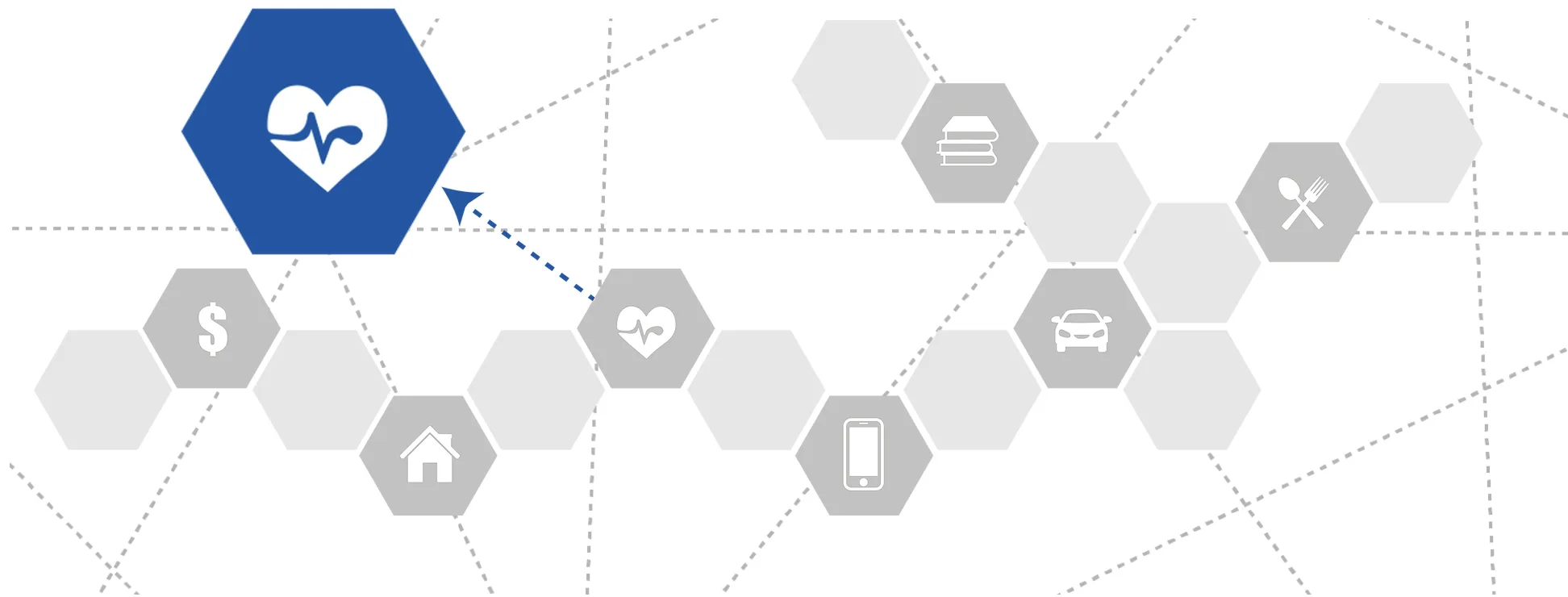
|
Housingclick to view |

|
Health Careclick to view |

|
Child Care and Educationclick to view |

|
Technologyclick to view |

|
Foodclick to view |

|
Taxesclick to view |

|
Transportationclick to view |
||
Future Trends: Health Care for ALICE Families
The trend of low-income households having poorer overall health will increase as health care and healthy food costs rise, and as the U.S. population ages. Seven overall trends will impact health care for ALICE and poverty-level families in the future:
The full impact of the ACA is not yet clear, nor is its long-term future. The ACA could improve health care by continuing to expand coverage through the Marketplace and Medicaid expansion. To date, the ACA rollout has increased the number of Community Health Centers, broken down language barriers by requiring health care to be provided in multiple languages, and increased hospital-based health education and investments in community health improvement.45 However, the ACA faces significant political opposition and the future of its policies and funding are not secure.
A small population may continue to be uninsured. With the future of the ACA in question, three groups of people may continue to face persistent problems with lack of insurance:
- Those who do not meet eligibility requirements for Medicaid: In many states without Medicaid expansion, people who earn less than the FPL may still not qualify for state Medicaid due to extremely strict eligibility requirements. And 2.2 million people in these states fall into a "coverage gap” between Medicaid eligibility and the minimum income required to receive an ACA premium subsidy.46
- People of color: Over half of the nonelderly uninsured population in 2017 were people of color. Hispanic people have the highest uninsured rates of all U.S. ethnic groups — 19 percent, compared to 7 percent for White adults. Common challenges to Hispanic people acquiring coverage include affordability, immigration status, and language barriers.47
- Low-income working families: Of families without insurance in 2017, more than 7 in 10 had at least one full-time worker, and an additional 10 percent had a part-time worker.48
More families will be underinsured. As health insurance costs continue to increase, families and employers will opt for lower-cost plans that offer less coverage.49
The shortage of doctors will continue, especially in rural areas and in economically stagnant areas. At current rates of utilization, demand for physicians is projected to grow by 17 percent nationally from 2013 to 2025, with a shortfall of at least 12,500 primary care physicians.50 The availability of primary care is especially important for cost-effective care, and the shortage of primary care doctors is a significant problem for low-income Americans, while shortages of dental and mental health providers are even more severe.51
More people will encounter the Medicaid benefits cliff. As companies and states pass policies that increase wages, some workers will lose their Medicaid coverage but will not earn enough to replace those benefits. The impact may be reduced as more gradual phasing out of benefits replaces strict eligibility limits.52
Demand for unpaid family caregivers will continue to increase as seniors age, and as the cost of health services for seniors increases beyond what many households can afford to pay. However, the number of caregivers available is decreasing as the ratio of working-age adults to seniors shifts. In 2010, there were 7 potential caregivers available for every 1 person over 80 years old in the U.S. By 2030, the ratio is expected to decline to 4 to 1, and then to 3 to 1 by 2050.53
Better health for ALICE and poverty-level families will continue to depend on having basic needs met. The interconnectedness of health and basic needs highlights the importance not only of basic health services and broad insurance coverage, but also of healthy communities and lifestyles. Building healthy communities requires cross-sector collaboration, and this work is time-consuming, expensive, and often slow to happen. State and federal budgets, political will, awareness of return on investment, and the willingness of various sectors to work together will affect whether these types of initiatives move forward.54
Sources
45
Paradise, J., Rosenbaum, S., Markus, A., Sharac, J., Tran, C., Reynolds, D., & Shin, P. (2017, January 18). Community health centers: Recent growth and the role of the ACA. Kaiser Family Foundation. Retrieved from https://www.kff.org/medicaid/issue-brief/community-health-centers-recent-growth-and-the-role-of-the-aca/
46
Garfield, R., Damico, A., Stephens, J., & Rouhani, S. (2015). The Coverage Gap: Uninsured Poor Adults in States that Do Not Expand Medicaid – An Update. Kaiser Family Foundation. Retrieved from http://files.kff.org/attachment/the-coverage-gap-uninsured-poor-adults-in-states-that-do-not-expand-medicaid-issue-brief
Kaiser Family Foundation. (2018, December 10). The number of uninsured people rose in 2017, reversing some of the coverage gains Under the Affordable Care Act. Retrieved from https://www.kff.org/uninsured/press-release/the-number-of-uninsured-people-rose-in-2017-reversing-some-of-the-coverage-gains-under-the-affordable-care-act/
Garfield, R., Orgera, K., & Damico, A. (2019, March 21). The coverage gap: Uninsured poor adults in states that do not expand Medicaid. Kaiser Family Foundation. Retrieved from http://kff.org/health-reform/issue-brief/the-coverage-gap-uninsured-poor-adults-in-states-that-do-not-expand-medicaid-an-update/
47
Garfield, R., Orgera, K., & Damico, A. (2019, March 21). The coverage gap: Uninsured poor adults in states that do not expand Medicaid. Kaiser Family Foundation. Retrieved from http://kff.org/health-reform/issue-brief/the-coverage-gap-uninsured-poor-adults-in-states-that-do-not-expand-medicaid-an-update/
Kaiser Family Foundation. (2018, December 10). The number of uninsured people rose in 2017, reversing some of the coverage gains Under the Affordable Care Act. Retrieved from https://www.kff.org/uninsured/press-release/the-number-of-uninsured-people-rose-in-2017-reversing-some-of-the-coverage-gains-under-the-affordable-care-act/
National Council of La Raza. (2014). New survey highlights barriers to access health care in Latino communities. Retrieved from http://blog.unidosus.org/2014/07/15/new-survey-highlights-barriers-access-health-care-latino-communities/
Perez, G. (2016). Latino state of enrollment: Persistent health disparities, barriers and gains under the ACA. Enroll America. Retrieved from https://www.slideshare.net/EnrollAmerica/latino-state-of-enrollment-persistent-health-disparities-barriers-and-gains-under-the-aca
48
Garfield, R., Orgera, K., & Damico, A. (2019, March 21). The coverage gap: Uninsured poor adults in states that do not expand Medicaid. Kaiser Family Foundation. Retrieved from http://kff.org/health-reform/issue-brief/the-coverage-gap-uninsured-poor-adults-in-states-that-do-not-expand-medicaid-an-update/
Kaiser Family Foundation. (2018, December 10). The number of uninsured people rose in 2017, reversing some of the coverage gains Under the Affordable Care Act. Retrieved from https://www.kff.org/uninsured/press-release/the-number-of-uninsured-people-rose-in-2017-reversing-some-of-the-coverage-gains-under-the-affordable-care-act/
49
National Association of Dental Plans. (2016). Who has dental benefits today? Retrieved from http://www.nadp.org/Dental_Benefits_Basics/Dental_BB_1.aspx
Medicare. (2016). Your Medicare coverage: Eye exams. Retrieved from https://www.medicare.gov/coverage/eye-exams.html
Collins, S. R., Bhupal, H. K., & Doty, M. M. (2019). Health insurance coverage eight years after the ACA: Fewer uninsured Americans and shorter coverage gaps, but more underinsured. The Commonwealth Fund. Retrieved from https://www.commonwealthfund.org/sites/default/files/2019-02/Collins_hlt_ins_coverage_8_years_after_ACA_2018_biennial_survey_sb.pdf
50
Association of American Medical Colleges. (2015). Physician supply and demand through 2025: Key findings. Retrieved from https://www.aamc.org/download/450420/data/physiciansupplyanddemandthrough2025.pdf
51
National Rural Health Association. (2017). About rural health care. Retrieved from https://www.ruralhealthweb.org/about-nrha/about-rural-health-care
52
Dague, L., DeLeire, T., & Leininger, L. (2014). The effect of Public insurance coverage for childless adults on labor supply (Working Paper No. 20111). National Bureau of Economic Research. Retrieved from http://www.nber.org/papers/w20111.pdf
Sloan, F., & Hsieh, C.-R. (2017). Health economics (2nd ed.). Retrieved from https://mitpress.mit.edu/books/health-economics-second-edition
53
Redfoot, D., Feinberg, L., & Houser, A. (2013, August). The aging of the baby boom and the growing care gap: A look at future declines in the availability of family caregivers. Retrieved from http://www.aarp.org/content/dam/aarp/research/public_policy_institute/ltc/2013/baby-boom-and-the-growing-care-gap-insight-AARP-ppi-ltc.pdf
54
Lavizzo-Mourey, R. (2015). President’s message: Weaving the threads of health. Robert Wood Johnson Foundation. Retrieved from https://www.rwjf.org/en/library/annual-reports/presidents-message-2015.html
Alonzo L. Plough. (2014). Building a culture of health. American Journal of Preventive Medicine. Retrieved from https://www.ajpmonline.org/article/S0749-3797(14)00404-8/abstract

